Ithacus was a 1966
study by Douglas, producers of the DC- series transport aircraft and
the Thor IRBM, for a sub-orbital troop transport.
The designer was Philip Bono, who reused elements of his
ROOST (Recoverable
One-stage Orbital Space Truck) and
ROMBUS (Reusable Orbital
Module-Booster & Utility Shuttle) studies from 1962 and 1964; these
were the first serious engineering proposals for reusable vertical
takeoff and vertical landing single-stage-to-orbit spacecraft.
This design family was based on an actively-cooled plug-nozzle engine,
a variable-geometry design with a movable blockage in the rocket
nozzle, which could change the shape of its exhaust to maintain
efficiency over a wide range of air pressures. Liquid hydrogen fuel
would be circulated through the plug to stop the latter from melting,
and this would also serve as an active heat shielding system during
re-entry. To lower the weight of things like skin and structure,
ROMBUS was to be huge, over 200 feet high (some sources say 95 but I
don't find this plausible), 78 feet across, with a fully-loaded weight
of over 6,000 tons and a payload capacity of 450 tons to LEO. (ROOST
was twice as heavy for the same capacity; ROMBUS got the weight down
by using jettisonable external hydrogen tanks rather than being fully
reusable.)
That was probably a reasonably workable idea, if very optimistic, but
the cost of building and testing such a huge vehicle would have been
far too high for NASA alone; so, perhaps inspired by USMC General
Wallace M. Greene who was proposing rapid-response forces, Bono
proposed an intercontinental troop carrier variant, the Ithacus, for
responding to "brush wars" before they got out of hand. This was
essentially the same engine and fuselage as ROMBUS, with the same 450
ton payload. It would carry a battalion of 1,200 soldiers ("Rocket
Commandoes"), plus equipment, on a sub-orbital flight path, thus
removing some of the need for American bases overseas and giving the
ability to respond to a crisis anywhere in the world in less than an
hour.
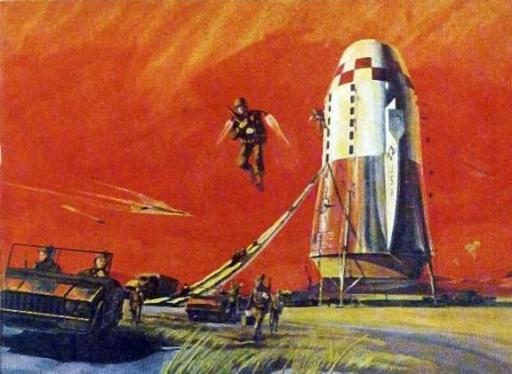
(The personal jet-pack appears to have been entirely a flight of fancy
on the part of the artist at NASA.)
Another version, the Ithacus Jr, would have carried 260 soldiers or
33.5 tons. These would be launched from an aircraft carrier, fuelled
by electrolysis driven by the carrier's nuclear power plants, and sent
in pairs: one full of troops, the other with all their equipment. (One
assumes this was to get US Navy buy-in for the project, but as the
illustration shows the carrier couldn't be used for much else until
after the hangar boxes had been removed.)
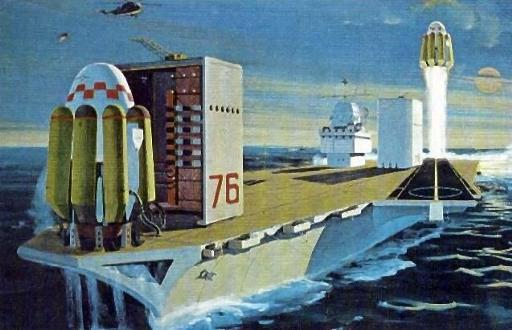
Recovery of the empty Ithacus would obviously present some
difficulties: if it were fully fuelled for a return flight, it would
need a proper launch facility in order for the massive thrust of its
main engines not to generate shockwaves and kick up huge amounts of
débris, damaging the vehicle as well as its surroundings. Reducing the
fuel load, so that it could take off with lower thrust and fly only a
few hundred miles at a time, was thought to be more practicable; then
it would be hauled aboard a Saturn-style crawler and moved onto a
cargo ship for return to the USA. But you'd still need to get liquid
hydrogen and oxygen into the recently-pacified trouble spot.
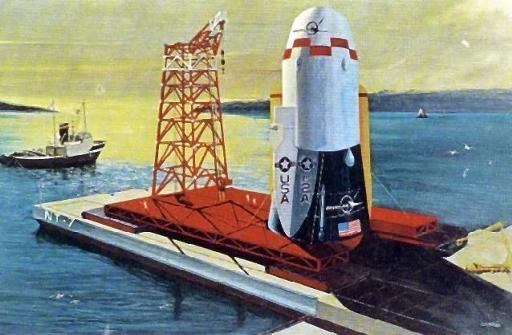
The tactical implications don't seem to have been studied in as much
detail. Consider: you are a Bad Guy by American standards. Your
military forces are causing trouble somewhere. You're probably more or
less aligned with the USSR. US reinforcements are on the way, coming
in nearly vertically, with a great big infra-red (landing thrust would
be a minimum of 10MN) and radar (from re-entry ionisation) trace; you
can't miss them, and they're not terribly agile. By 1966 the S-75
Dvina (SA-2 Guideline) surface-to-air missile, with its 200kg
warhead and 82,000 foot ceiling, has been in service for nearly ten
years: the North Vietnamese have them (as the USAF is finding to its
cost). Now I don't know just how damageable the plug-nozzle engine
would be, but this is certainly a thin-skinned aircraft, and if you
can knock it out at any sort of altitude all 1,200 troops are out of
action before they can fire a single bullet. You also score a huge
publicity coup: "They dropped soldiers on us from space, and we
still beat them!" So the Ithacus can't drop "anywhere in the
world" – it has to be somewhere out of any conceivable hostile SAM
cover, and then the troops have to go overland to where the fighting
is. (Even then, accidents are much less survivable than accidents to
aerodynamic transport aircraft.)
A payload allowance of 826lb per soldier, including their own body
weight, doesn't allow for anything in the way of heavy equipment: it's
about 20% more than the allowance for paratroopers aboard a C-130.
This is a very light infantry unit, with no tanks or even APCs (the
contemporaneous M113 weighs around 2,100lb per soldier, even without
the troops and their personal kit).
Also: what happens if they don't immediately win? It's like an
amphibious or parachute assault: you aren't going back the way you got
in, and you don't have much in the way of spare ammunition or food.
Only you don't really want to leave your hugely expensive assault
spacecraft lying around for the enemy to capture, so you'll probably
have to destroy it if things go badly…
So in how many situations do you have a non-SAM-covered landing zone
where 1,200 light troops can be reasonably sure of winning the fight?
Ithacus Jr suffers further because it reduces that to 260 troops with
even less equipment, and given the huge range of the thing, putting it
aboard an aircraft carrier just seems pointless: why send it in from
an ocean launch when you could send it in from the continental USA in
only a few minutes more?
There's also the concern that, well, the USA launching a great big
suborbital rocket towards a trouble spot just might be interpreted
as an ICBM.
This may be part of why the idea never went anywhere, though given
some of the things that did get built I suspect it was mostly the
cost. Bono went on to design the smaller
Pegasus VTOVL
(intended for very-high-speed transport and disaster relief, bearing
in mind this was also the age of Concorde and other SST development)
and SASSTO vehicles; none
of his designs was built, and he died three months before the first
flight of the loosely related DC-X.
The complete failure of the project to get anywhere didn't stop it
from being included in The Usborne Book of the Future (1979), a huge
influence on the young RogerBW. These images are very clearly inspired
by the NASA art for Ithacus and Pegasus VTOVL.
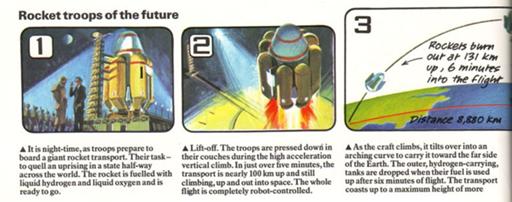
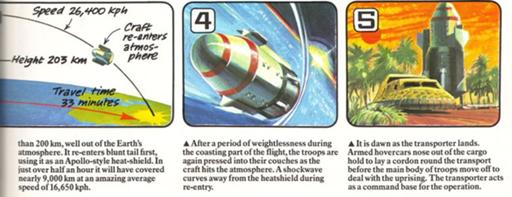
One consideration that rarely gets mentioned is that a suborbital
transport like this is basically the same thing as a full space launch
vehicle: the speed through the atmosphere and delta-V demands are high
enough that you can't take significant short-cuts just because it's
not intended to achieve orbit. This isn't a simple up-and-down trip
like SpaceShipOne: you need nearly as much sideways speed as if you're
going all the way. (I suspect that heavy lift to orbit was always
Bono's real goal anyway.)
The idea of a suborbital troop transport was resurrected in 2002, with
the USMC's SUSTAIN (Small Unit Space Transport and Insertion) concept
(possibly to use the USAF's HOT EAGLE). This time, rather than
worrying about foreign bases, the idea was to avoid having to ask
countries for overflight rights; this seems largely to have been
spurred by a failed mission in November 2001 to try to find Osama bin
Laden, where the USA actually had to negotiate with Pakistan in
order to move its troops through Pakistani airspace. Imagine!
This is all very much on paper, but the scheme was for a two-stage
vehicle based loosely on SpaceShipOne (ahem, see above). This was to
carry 13 Marines plus their equipment, and land on a runway rather
than vertically. So you wouldn't have quite such a huge infra-red
plume, but to all the other problems you've now added the need for a
conflict where 13 Marines can make a difference (someone's been
watching too many action films), and where the enemy can't park a
truck across the runway. (Hey, why not have them parachute out?) The
only nominal point of this is that national airspace claims currently
end at 50 miles altitude, but does anyone in the US really expect a
foreign country to say "oh, you flew over us at 51 miles up, we're
just fine with that, rah rah Murica"? This got some talk in 2005-2006
but seems to have faded away since then.
But the concept art is really cool.
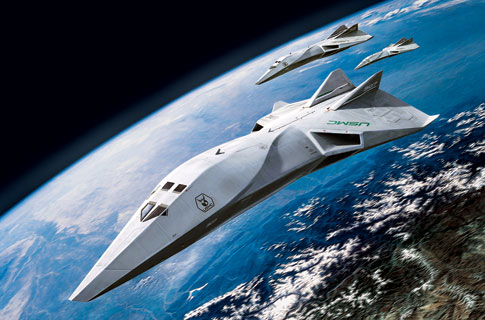
(I believe this is by Peter Bollinger, working for Popular Science.)
How could the idea be a useful one? Really you need something better
than conventional rockets, just as you do for a cheap surface-to-orbit
launcher. Use one of the nuclear engine designs, particularly one that
can heat air for thrust while in atmosphere, and the payload starts to
be a larger fraction of the overall vehicle mass. And as the fuel mass
goes down, you might get a certain amount of ability to manoevure as
well: something that can make a suborbital insertion to a few hundred
miles out from the trouble spot, then hedge-hop at supersonic speeds,
might have more of a chance. Keep it small, to put in a squad or two,
and frankly to be more expendable than a 1,200-soldier craft. It's
useful for embassy hostage rescues and similar small sudden missions.
Throttle down, air-drop the troops or land vertically, and fly away
again; you still have a limited range of conflicts in which it does
much good, and it's probably not worth the money to develop unless
you're also using it as a general-purpose space launcher, but at
least it can have some effect.
Comments on this post are now closed. If you have particular grounds for adding a late comment, comment on a more recent post quoting the URL of this one.